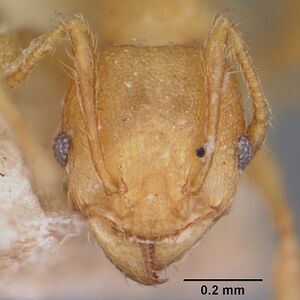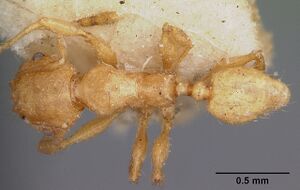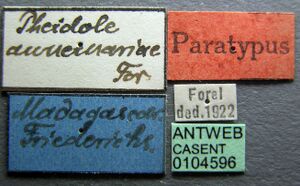Pheidole annemariae
| Pheidole annemariae | |
|---|---|

| |
| Scientific classification | |
| Kingdom: | Animalia |
| Phylum: | Arthropoda |
| Class: | Insecta |
| Order: | Hymenoptera |
| Family: | Formicidae |
| Subfamily: | Myrmicinae |
| Tribe: | Attini |
| Genus: | Pheidole |
| Species group: | annemariae |
| Species: | P. annemariae |
| Binomial name | |
| Pheidole annemariae Forel, 1918 | |
The species was collected between 3–1343 m in elevation, in rainforest, littoral rainforest, montane rainforest, and occasionally beach vegetation on sandy soil. Nests were located in rotten logs and branches, and once in canopy (Salata & Fisher, 2020).
Identification
Salata and Fisher (2020) - A member of the Pheidole annemariae species group. Head in full-face view rectangular, slightly longer than wide, anterior of eyes slightly convex, posterior of eyes convex; sides of the head with moderately dense, long, erect pilosity; antennal scrobes present, impressed and not delimited; scrobe surface rugo-foveolate, with distinct, thin, moderately sparse, longitudinal rugae; propodeal spines long (PSL: 0.21-0.24 (0.22)); gaster finely shagreened; inner hypostomal teeth distinct, moderately high, closely spaced, triangular, with rounded apex and moderately narrow base; outer hypostomal teeth approximately the same size as inner hypostomal teeth, triangular; inner and outer teeth closely spaced and connected by indistinct concavity. Minor:. Head foveolate, genae smooth; propodeal spines long (PSL: 0.15-0.18 (0.16)); promesonotum low, slightly convex, short, with posterior declivity relatively steep; mesonotal spines present; mesosoma foveolate, katepisternum and mesonotum with smooth notches.
Pheidole annemariae is most similar to Pheidole marieannae. Majors workers. It differs from P. marieannae in presence of smooth notch on genae, inner and outer teeth closely spaced and connected by indistinct concavity, posterior mesonotum with distinct teeth-like projections, and longer propodeal spines. Minor workers. It differs from P. marieannae in presence of small but distinct mesonotal spines and katepisternum, anepisternum, and mesonotum never entirely smooth.
Distribution
Distribution based on Regional Taxon Lists
Malagasy Region: Madagascar (type locality).
Distribution based on AntMaps
Distribution based on AntWeb specimens
Check data from AntWeb
Countries Occupied
| Number of countries occupied by this species based on AntWiki Regional Taxon Lists. In general, fewer countries occupied indicates a narrower range, while more countries indicates a more widespread species. |

|
Estimated Abundance
| Relative abundance based on number of AntMaps records per species (this species within the purple bar). Fewer records (to the left) indicates a less abundant/encountered species while more records (to the right) indicates more abundant/encountered species. |

|
Biology
Castes
Worker
Minor
   
| |
| . | |
Images from AntWeb
   
| |
| Type of Pheidole annemariae. Worker. Specimen code casent0104597. Photographer April Nobile, uploaded by California Academy of Sciences. | Owned by ZMHB, Berlin, Germany. |
   
| |
| Syntype of Pheidole annemariae. Worker. Specimen code casent0101829. Photographer April Nobile, uploaded by California Academy of Sciences. | Owned by MHNG, Geneva, Switzerland. |
Major
Images from AntWeb

| |
| Worker (major/soldier). Specimen code casent0077290. Photographer Michele Esposito, uploaded by California Academy of Sciences. | Owned by CAS, San Francisco, CA, USA. |
   
| |
| Type of Pheidole annemariae. Worker (major/soldier). Specimen code casent0104596. Photographer April Nobile, uploaded by California Academy of Sciences. | Owned by ZMHB, Berlin, Germany. |
  
| |
| Worker (major/soldier). Specimen code casent0101688. Photographer April Nobile, uploaded by California Academy of Sciences. | Owned by MHNG, Geneva, Switzerland. |
Queen
Images from AntWeb
   
| |
| Queen (alate/dealate). Specimen code casent0101653. Photographer April Nobile, uploaded by California Academy of Sciences. | Owned by MHNG, Geneva, Switzerland. |
Nomenclature
The following information is derived from Barry Bolton's Online Catalogue of the Ants of the World.
- annemariae. Pheidole annemariae Forel, 1918b: 152 (s.w.q.) MADAGASCAR.
Unless otherwise noted the text for the remainder of this section is reported from the publication that includes the original description.
Description
Worker
Salata and Fisher (2020) - Major (N = 10): HL: 1.16-1.3 (1.21); HW: 1.06-1.19 (1.11); SL: 0.5-0.52 (0.51); EL: 0.13-0.16 (0.14); WL: 0.87-1.02 (0.93); PSL: 0.21-0.24 (0.22); MTL: 0.51-0.56 (0.53); PNW: 0.56-0.64 (0.59); PTW: 0.13-0.16 (0.15); PPW: 0.38-0.47 (0.43); CI: 90.7-93.9 (91.8); SI: 43.5-47.6 (46.2); PSLI: 17.6-20.1 (18.6); PPI: 31.1-38.1 (33.8); PNI: 51.2-55.2 (53.0); MTI: 44.7-50.0 (47.6). Head. In full-face view rectangular, slightly longer than wide, anterior of eyes slightly convex, posterior of eyes convex, occipital margins of lobes slightly convex. In lateral view sub-rectangular; ventral and dorsal faces finely convex; dorsal face finely depressed posteriorly, forming shallow transverse depression between frons and occipital lobes; inner hypostomal teeth visible. In lateral view weakly impressed on vertex. Sides of the head with moderately dense, long, erect pilosity; whole head with dense, moderately long, suberect to erect pilosity. Antennal scrobes indistinct and not delimited by carinulae; scrobe surface rugo-foveolate, with distinct, thin, moderately sparse, longitudinal rugae. Occipital lobes shiny, with thick, sparse, irregular rugae, interspaces with fine rugulae fading posteriorly; frons with moderately sparse, thick, longitudinal, and sometimes interrupted rugae, interspaces variable, smooth to finely rugoreticulate, most often rugoreticulation fading on the central part of frons; genae with dense, fine and irregular rugulae, area behind eyes with smooth notch; malar area with thick, sparse, longitudinal rugae, interspaces rugoreticulate. Centre of clypeus shiny and sometimes with indistinct, short rugulae, lateral sides with sparse and longitudinal rugae; median notch present, moderately wide and shallow; median longitudinal carina present; lateral longitudinal carinae present. Scape, when laid back, reaching the midlength of head; pilosity suberect to erect. Inner hypostomal teeth distinct, moderately high, closely spaced, triangular, with rounded apex and moderately narrow base; outer hypostomal teeth approximately the same size as inner hypostomal teeth, triangular; inner and outer teeth closely spaced and connected by indistinct concavity. Mesosoma. In lateral view, promesonotum low and arched, dorsal mesonotum finely concave, posterior mesonotum relatively steep, with distinct teeth-like projections; promesonotal groove absent; metanotal groove absent; propodeal spines long, triangular, with sharp apex and moderately wide base; humeral area laterally weakly produced. Surface variable; promesonotum finely foveolate to rugo-foveolate, foveolae or rugo-foveolae always fading on lateral sides of pronotum and promesonotal dorsum, sometimes dorsal surface with smooth notch on its centre, additional indistinct, sparse, and vertical rugulae cover promesonotal dorsum and sometimes also its lateral sides; anepisternum and katepisternum rugo-foveolate, katepisternum with smooth notch on its central part; propodeum rugo-foveolate, its dorsoventral surface and lower part of lateral sides with fading sculpture. Pilosity moderately dense, long, erect. Petiole. Shiny; peduncle moderately long, foveolate, with indistinct horizontal lobes on its basal part; node relatively high, moderately thick, with rounded apex, in rear view node with shallow dorsoventral concavity or straight; pilosity moderately sparse and erect. Postpetiole. Shiny and foveolate, its dorsum with fading sculpture; in dorsal view sides with moderately long, wide, acute, and triangular projections; pilosity long and erect. Petiole. Shiny and finely shagreened; pilosity moderately dense, long, and erect. Colour. Brown to brownish black; legs yellowish brown.
Unless otherwise noted above, the following characters occur in this species, and the majority of Pheidole majors of Madagascar described by Salata and Fisher 2020a. Antennal sockets shallow; frontal lobes absent; head in full-face view with distinct median concavity; antenna 12-segmented, with 3-segmented club; masticatory margin of mandible with large, stout apical and preapical teeth, followed by a long diastema and then a short and crenulate tooth just before the rounded basal angle; outer surface of mandible mostly smooth and shining, sometimes with weak and sparse foveolae; antennal scrobes present; promesonotum strongly convex, well above the level of propodeum; postpetiole short with slightly convex dorsum; ventral process absent.
Minor (N = 10): HL: 0.52-0.57 (0.54); HW: 0.48-0.54 (0.5); SL: 0.47-0.51 (0.48); EL: 0.11-0.12 (0.11); WL: 0.62-0.67 (0.64); PSL: 0.15-0.18 (0.16); MTL: 0.36-0.41 (0.39); PNW: 0.32-0.35 (0.34); PTW: 0.06-0.08 (0.07); PPW: 0.12-0.16 (0.13); CI: 89.3-94.6 (92.4); SI: 92.1-102.3 (97.6); PSLI: 29.3-31.9 (30.7); PPI: 50.0-60.5 (55.8); PNI: 65.1-70.4 (67.5); MTI: 73.5-80.3 (77.8). Head. Occipital margin straight or indistinctly concave; occipital carina indistinct. Pilosity moderately dense, long, suberect. Head foveolate; frons sometimes with fading sculpture; genae smooth. Clypeus finely foveolate with additional short, longitudinal rugulae; median longitudinal carina absent; two lateral longitudinal carinae absent. Scape, when laid back, surpassing the posterior head margin by two-fifths of its length; pilosity suberect to erect. Mesosoma. In lateral view, promesonotum low, slightly convex, short, with posterior declivity relatively steep; mesonotal spines present, small and triangular, promesonotal groove absent; metanotal groove absent; propodeal spines long, triangular, with acute apex and narrow base. Sculpture foveolate; katepisternum and mesonotum with smooth notches. Pilosity sparse, short, and erect. Petiole. Peduncle relatively short and thin; with few short, erect setae. Postpetiole. Short, low and convex; with few short, erect setae. Petiole. With sparse, erect pilosity. Colour. Yellow.
Unless otherwise noted above, the following characters occur in this species, and the majority of Pheidole minors of Madagascar described by Salata and Fisher 2020a. Antennal sockets shallow; frontal lobes absent; head in full-face view oval, posterior and anterior of eyes convex; antenna 12-segmented, with 3-segmented club; humeral area not developed; clypeus smooth and shiny; its anterior margin regularly convex; promesonotum well above the level of propodeum; petiole smooth; petiole with node moderately low, triangular and small postpetiole smooth; gaster smooth and shiny.
Type Material
- Lectotype (designated by Salata & Fisher, 2020): major worker (middle specimen, CASENT0101688): Madagascar, Toamasina, Ilôt Prune, coll. Friederichs (MHNG) [examined].
- Paralectotypes: 2 major workers (CASENT0810541, top and bottom specimens, the same pin as lectotype) (MHNG) [examined], 3 minor workers (CASENT0101829) (MHNG) [examined], 1 minor worker (CASENT0923206) (MHNG) [examined]: the same data as lectotype.
References
- Ashigar, M.A., Ab Majid, A.H. 2021. Morphological reassessments and DNA barcoding of Pheidole rugaticeps Emery and Pheidole decarinata Santschi collected in Nigeria. International Journal of Tropical Insect Science, 421, 403–413 (doi:[https://doi.org/10.1007%2Fs42690-021-00557-w 10.1007/s42690-021-00557-w
]).
- Fischer, G., Friedman, N.R., Huang, J.-P., Narula, N., Knowles, L.L., Fisher, B.L., Mikheyev, A.S., Economo, E.P. 2020. Socially parasitic ants evolve a mosaic of host-matching and parasitic morphological traits. Current Biology 30, 3639–3646.e4 (doi:10.1016/j.cub.2020.06.078).
- Forel, A. 1918b. Quelques fourmis de Madagascar récoltées par le Dr. Friederichs et quelques remarques sur d'autres fourmis. Bull. Soc. Vaudoise Sci. Nat. 52: 151-156 (page 152, soldier, worker, queen described)
- Salata, S., Fisher, B.L. 2020a. Pheidole Westwood, 1839 (Hymenoptera, Formicidae) of Madagascar – an introduction and a taxonomic revision of eleven species groups. ZooKeys 905: 1–235 (doi:10.3897/zookeys.905.39592).
- Wheeler, W. M. 1922k. Ants of the American Museum Congo expedition. A contribution to the myrmecology of Africa. IX. A synonymic list of the ants of the Malagasy region. Bull. Am. Mus. Nat. Hist. 4 45: 1005-1055 (see also)
References based on Global Ant Biodiversity Informatics
- Fisher B. L. 1997. Biogeography and ecology of the ant fauna of Madagascar (Hymenoptera: Formicidae). Journal of Natural History 31: 269-302.
- Fisher B. L. 2003. Formicidae, ants. Pp. 811-819 in: Goodman, S. M.; Benstead, J. P. (eds.) 2003. The natural history of Madagascar. Chicago: University of Chicago Press, xxi + 1709 pp.
